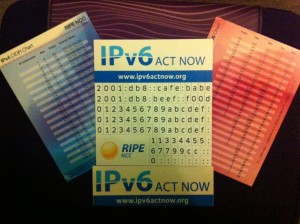I’ve just spent most of the morning in a “breakfast briefing” at Easynet, where Nigel Titley (RIPE NCC Chairman, 6UK Chairman and also Easynet’s Global Peering and Transit Manager) was evangelising about IPv6.
Although the general theme was very similar to much of the written content on the subject, namely IPv4 depletion and how it could really mess-up your decade if you don’t at least start looking an IPv6 migration soon, it was quite refreshing to get an insight straight from the “horse’s mouth”.
I found Nigel’s perspective quite unique, as he has one foot in the regulator’s camp and one foot in service provider’s. His knowledge and obvious passion for the progress of IPv6 adoption, seems only to be tempered by the apparent lethargy of content and services providers (and the platforms they sell) to get out of the way of the oncoming juggernaut that is IPv4 address depletion.
The briefing also contained a fair amount of anecdotes, including “NAT is EVIL”, which was said with such vigour that it reminded me of my Advanced Networking module at university, where the choice-phrase of the semester was “ATM must DIE!” [we even had this slogan printed on t-shirts, what geeks we were].
Getting back to the briefing…I was also able to add to my collection of IPv6 address space analogies. I was also quite fond of the following one, which was used to describe the state of IPv4 address allocation today:
"There are no more coming off the factory floor....the only ones left are those still on the supermarket shelfs"
During the Q and A session after the presentation, there where a mixture of queries. One delegate was very interested with the effect that IPv6 and its built-in security, will have on law enforcement. This smelt like snooping secret squirel stuff to me. I also learnt today that until recently IPv6 was illegal in France, for the same security reasons (i.e. encryption without giving the goverment authorities your keys).
I was able voice my main concern with IPv6 and its adoption:
The need for IPv6 is clear, and a viable migration strategy is dual-stacking. But at some point there will be no IPv4 addresses to give out. Therefore a suitable bridging/mapping technology needs to adopted. Who is going to be responsible for that? The Internet user community needs better visibility about the techniques that can be and are going to be used, and how this will affect current [legacy] and future network service roll-out?
To their credit, the guys at Easynet did take this request for information onboard, and promised to produce a road-map and distribute more implementation details to their user-base and partners.
Before bringing his presentation to a close, Nigel casually asked how “many bit are in a IPv6 addresses?” and I glibly answered “128”….apparently this question won me a prize, and the RIPE chairman then threw a “IPv6 - Act Now” fridge magnet at me…for a second I though it was being thrown in anger, and that all those slightly exaggerated RIPE IP justification had come back to haunt me!
[caption id=“attachment_199” align=“aligncenter” width=“300” caption=“Aforementioned Fridge Magnet and other IPv6 related paraphernalia”] [/caption]
[/caption]
[caption id=“attachment_200” align=“aligncenter” width=“224” caption=“Fridge Magnet In Situ”] [/caption]
[/caption]
So….all I have to do now is digest all the information, rip-off the presentation, and prepare for a update session to my own client-base on the same subject. I hope I don’t get too many hard questions…but I guess Kharma will decide.
✴️ Also on Micro.blog